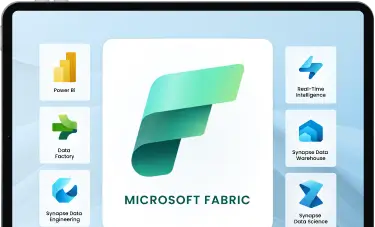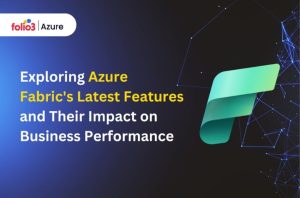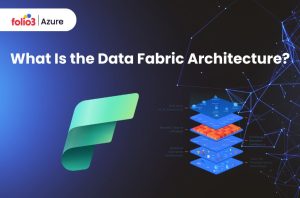Table of Contents
ToggleDuring the recent years, data has become the core of every operation. Accessing and managing data efficiently and easily is an absolute necessity for businesses trying to milk their data’s power.
Microsoft Fabric is an end-to-end analytics and data platform exclusively developed for organizations wanting collective solutions. Power BI Gateway is a software tool for accessing data that resides on an on-premises network. The request for data access, coming from any web-based or cloud-based application has to pass through this gateway.
You can simplify your data access by integrating Power BI Data Gateway with Microsoft Fabric. This powerful connection between Power BI Data Gateway and Microsoft Fabric enhances your analytics skills enables smooth access to both on-premises and cloud data and positively impacts your data management strategy.
Let’s examine the core components of this powerful integration and see how it can improve your data analysis and management.
Accelerate smart decisions with Microsoft Fabric's unified data and AI analytics.

What is Power BI Data Gateway?
If we put it simply, the Power BI Data Gateway is a bridge that facilitates secure data transfer between on-premises data sources and Power BI, Power Apps, and other Microsoft cloud services.
You might consider as an important connection that enables communication between your on-premise data and the cloud. Hence, letting you make data-driven decisions without the hurdle of data silos.
Key Features of Power BI Data Gateway
- Secure Data Connectivity: The Power BI Data Gateway creates a secure connection to your on-premises data without the requirement of moving it to the cloud. This means that you are able to keep your sensitive data within the bounds of your secure environment while still using cloud analytics capabilities.
- Automatic Data Refresh: You can set up automatic data refreshes to make sure that your reports and dashboards always contain the most updated information. Keeping your data insights accurate and useful depends on doing this.
- Centralized Management: It provides you with a unified platform for managing connections with various data sources. Thus, making it easier to monitor your data environment. This centralized strategy reduces the complexities of managing multiple data sources and connections.
- High Availability and Scalability: The Power BI gateway provides configurations that are readily available and can scale with your organization’s increasing data needs. This warrants that your integration will always remain useful as your data demands increase.
- Integration with Multiple Services: The Data Gateway integrates with other Microsoft services beyond Power BI. These include Azure Analysis Services and Power Apps, enabling you to benefit from a complete suite of tools for your data requirements.
Using the Power BI Data Gateway with Fabric, you can guarantee simplified and smooth data access that leads to better performance while maintaining immaculate security.
Why Integrate Power BI Data Gateway with Microsoft Fabric?
Integrating the Power BI Data Gateway with Microsoft Fabric is a must for any organization striving to improve its data access and analysis. Here are some of the challenges you might face without this integration:
1. Data Silos
Quite often the data is residing at multiple disparate locations, and accessing data from these sources can be challenging in the absence of a centralized approach. When data is trapped in silos, it limits your ability to get complete data insights.
For example, understanding the relationship between sales performance and customer behavior becomes daunting if your sales data resides in one system while customer data is in another.
2. Manual Data Handling
Without proper integration, you will find yourself managing data manually, leading to errors arising from manual data manipulation. Manual processes tend to be time-consuming and prone to errors, which can result in inaccurate reporting and decision-making.
3. Delayed Insights
Outdated insights resulting from a lack of real-time data access can hinder swift decision-making. Real-time data access is important for making prompt, well-informed decisions in busy business environments. For example, if you’re monitoring sales data to adjust marketing strategies, outdated data can lead to missed opportunities.
Benefits of Combining Power BI Data Gateway with Microsoft Fabric
Integrating Power BI Data Gateway with Microsoft Fabric results in significant benefits:
1. Secure and Efficient Data Flow
This powerful integration lets you move data securely between your on-premises sources and the cloud, establishing data integrity and compliance. This means your organization can adhere to regulatory requirements while using cloud analytics.
2. Real-time Analytics and Insights
After this integration, you can accomplish real-time analytics, giving you the most updated data insights for accurate decision-making. Imagine being able to analyze customer interactions and sales data simultaneously to improve your marketing strategies in real time.
3. Centralized Data Management and Monitoring
It lets you manage all your data sources from one place, empowering you with high visibility and control of your data environment. This centralized approach simplifies data management and improves collaboration between teams.
4. Enhanced Collaboration Across Teams
Integrating Power BI with Microsoft Fabric allows different departments to access shared data and insights, thus promoting a highly collaborative environment. This also means that all teams are on the same page and work together towards common business goals.
Integrating Power BI Data Gateway with Microsoft Fabric improves the performance of your analytics and simultaneously simplifies your data management.
Steps to Integrating Power BI Data Gateway With Microsoft Fabric
Now that you are aware of the importance of this strong integration, let’s discuss the essential steps needed to successfully integrate Power BI Data Gateway with Fabric.
Step 1: Setting Up Power BI Data Gateway
Installation and Configuration Prerequisites
Before you begin with the installation you must make sure you have the following:
- A machine that meets the system requirements for installing the Power BI gateway. Check the official Microsoft documentation for the most recent requirements.
- Administrative rights on the machine for installation. This is essential for configuring network settings and managing connections.
After you make sure that you have these prerequisites, you can proceed with the installation. The installation process is simple and can be completed by downloading the gateway from Microsoft’s website and following the setup wizard.
Connecting to On-premise Data Sources
After you are done with the installation, you must connect the gateway to your on-premises data sources. This involves selecting the data sources you want to connect to and setting up the connection settings.
You must provide credentials and test the connection to guarantee that it’s established correctly. This step is vital as it lays the foundation for your data integration.
Step 2: Configuring Microsoft Fabric
Creating a Data Pipeline in Microsoft Fabric
In the next step, you need to configure Microsoft Fabric. This consists of creating a data pipeline that establishes how data transmits from your on-premises sources to your cloud applications. Using Microsoft Fabric, you can visually design your data pipeline, and specify data transformations, scheduling, and integration.
Setting Up Endpoints and Connecting to Power BI
After setting up your data pipeline, you must configure endpoints that connect Microsoft Fabric to Power BI. This will establish a smooth data flow between the two platforms, ensuring you can access your data whenever you need it. Proper configuration at this stage is important so that Power BI can extract all the data required from Fabric without any bottlenecks.
Step 3: Establishing the Integration
Linking Power BI Data Gateway to Microsoft Fabric Pipelines
After your endpoints are configured, the next step is linking the Power BI Data Gateway to the pipelines you created in Microsoft Fabric. This connection is mandatory for assuring that your data flows easily from your local environment to the cloud. It’s essential to verify that the correct data sources are mapped to the proper pipelines.
Testing the Connection for Seamless Data Flow
Now that you have established the link, it’s important to test the connection. This step will verify that data is flowing as expected. This is also required for troubleshooting any issues that might arise during the integration. You can monitor data transfer logs and performance metrics to identify errors.
Step 4: Managing Data Access and Security
Ensuring Data Integrity and Security
As you move ahead and integrate Power BI Data Gateway with Microsoft Fabric, you must focus on data integrity and security. You can put up security measures such as encryption and secure network protocols to safeguard your data during transfer. Check that your gateway is configured according to industry security standards and meets all the compliance requirements.
Role-Based Access Control Within Microsoft Fabric
Putting up role-based access control (RBAC) will help you restrict who has access to what data in your organization. This is essential for data security and guaranteeing that sensitive information is only available to authorized personnel. You can define roles and permissions according to job responsibilities, letting your teams collaborate easily while maintaining data security.
Conclusion
Integrating Power BI Data Gateway with Microsoft Fabric can refine and reshape your data management techniques. This is achieved by providing safe access to both on-premises and cloud data sources.
Following the steps discussed in this article, you can move ahead with a painless integration process that maximizes your Power BI performance and provides real-time analytics.
Considering the benefits of this integration, you must think about how it can transform your organization’s data capabilities. If you’re ready to take the next forward, you must explore the services available through Azure, which can further boost your data integration endeavors.
Let’s pave the way for better data insights, intelligent decisions, and the long-term success of your organization.


